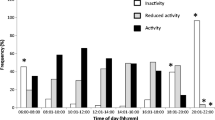Summary
The females of the dragonfly Aeschna cyanea visiting ponds vary in their receptiveness to males waiting there. Individual males pay several short visits to a mating place in the course of a day, searching for receptive females. Non-receptive females prefer to oviposit at the pond in the evening, whereas receptive females arrive throughout the day. The highest number of receptive females is found on warm days during the afternoon at which time the greatest number of copulations occur. However, as the number of males and, therefore, the competition between males is also highest during these periods, the mating chances of a particular male are constant throughout the day.
Similar content being viewed by others
References
Bartenef A (1932) Über die Tageskurven des Fluges von Aeschna juncea L. (Odonata) in Hochgebirgsgewässern. Zool Anz 98:91–94
Campanella PJ (1975) The evolution of mating systems in temperate zone dragonflies (Odonata: Anisoptera). II. Libellula luctuosa (Burmeister). Behaviour 54:278–309
Campanella PJ, Wolf LL (1974) Temporal leks as a mating system in a temperate zone dragonfly (Odonata: Anisoptera). I: Plathemis lydia (Drury). Behaviour 51:4–87
Corbet PS (1980) Biology of Odonata. Annu Rev Entomol 25:189–217
Corbet SA (1960) The larval development and emergence of Aeshna cyanea (Müll.) (Odon., Aeshnidae). Entomol Month Mag 95:241–245
Fincke OM (1982) Lifetime mating success in a natural population of the damselfly, Enallagma hageni (Walsh) (Odonata: Coenagrionidae). Behav Ecol Sociobiol 10:293–302
Fincke OM (in press) Lifetime reproductive success and the opportunity for sexual selection in a short-lived damselfly (Odonata: Coenagrionidae). Evolution (in press)
Fretwell SD (1972) Populations in s seasonal environment. Princeton University Press, Princeton
Heymer A (1969) Fortpflanzungsverhalten und Territorialität bei Orthetrum coerulescens (Fabr., 1798) und O. brunneum (Fonsc., 1837) (Odonata: Anisoptera). Rev Comp Anim 3:1–24
Higashi K (1969) Territoriality and dispersal in the population of dragonfly, Crocothemis servilia Drury (Odonata: Anisoptera). Mem Fac Sci Kyushu Univ Ser E 5:95–113
Jacobs ME (1955) Studies on territorialism and sexual selection in dragonflies. Ecology 36:566–586
Kaiser H (1974a) Verhaltensgefüge und Temporialverhalten der Libelle Aeschna cyanea (Odonata). Z Tierpsychol 34:398–429
Kaiser H (1974b) Die Regelung der Individuendichte bei Libellenmännchen (Aeschna cyanea, Odonata). Oecologia (Berl) 14:53–74
Kaiser H (1974c) Die tägliche Dauer der Paarungsbereitschaft in Abhängigkeit von der Populationsdichte bei den Männchen der Libelle Aeschna cyanea (Odonata). Oecologia (Berl) 14:375–387
Kaiser H (1974d) Intraspezifische Aggression und räumliche Vertcilung bei der Libelle Onychogomphys forcipatus (Odonata). Oecologia (Berl) 15:223–234
Kaiser H (1976) Räumliche und zeitliche Aufteilung des Paarungsplatzes bei Großlibellen (Odonata, Anisoptera). Verh Ges Ökol Wien 1975:115–120
Kaiser H (1982) Do Cordulegaster males defend territories? A preliminary investigation of mating strategies in Cordulegaster boltoni (Donovan) (Anisoptera: Cordulegasteridae). Odonatologica 11:139–152
Krüner U (1977) Revier- und Fortpflanzungsverhalten von Orthetrum cancellatum (Linnaeus) (Anisoptera: Libellulidae). Odonatologica 6:263–270
McVey ME (1981) Lifetime reproductive tactics in a territorial dragonfly, Erythemis simplicicollis. Thesis, Rockefeller University, New York
Parker GA (1970) The reproductive behaviour and the nature of sexual selection in Scatophaga stercoraria L. (Diptera: Scatophagidae). II. The fertilization rate and the spatial and temporal relationships of each sex around the site of mating and oviposition. J Anim Ecol 39:205–228
Parr MJ (1983) An analysis of territoriality in Libellulid dragonflies (Anisoptera: Libellulidae). Odonatologica 12:39–57
Pezalla VM (1979) Behavioral ecology of the dragonfly Libellula pulchella Drury (Odonata: Anisoptera). Am Midl Nat 102:1–22
Poethke HJ, Kaiser H (1985) A simulation approach to evolutionary game theory: the evolution of time-sharing behaviour in a dragonfly mating system. Behav Ecol Sociobiol (in press)
Ubukata H (1984) Oviposition site selection and avoidance of additional mating by females of the dragonfly, Cordulia aenea amurensis Selys (Corduliidae). Res Popul Ecol 26:285–301
Waage JK (1984) Sperm competition and the evolution of Odonate mating systems. In: Smith RL (ed) Sperm competition and the evolution of animal mating systems. Academic Orlando, pp 251–290
Author information
Authors and Affiliations
Rights and permissions
About this article
Cite this article
Kaiser, H. Availability of receptive females at the mating place and mating chances of males in the dragonfly Aeschna cyanea . Behav Ecol Sociobiol 18, 1–7 (1985). https://doi.org/10.1007/BF00299231
Received:
Accepted:
Issue Date:
DOI: https://doi.org/10.1007/BF00299231




